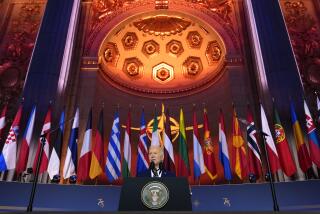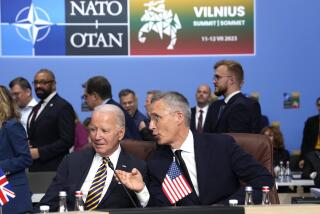Speaking of... : The Expanding U.N.
- Share via
TRENDS IN UNITED NATIONS MEMBERSHIP
The United Nations grew slowly in its first decade. Cold War tensions mounted between the permanent members of the Security Council--China, France, Britain, the U.S.S.R. and the United States--and only nine of 31 applicants were accepted for admission.
In 1955, a Canadian-led compromise was supported by the General Assembly and the Security Council, and 16 new members were added. Membership increased steadily from that point.
The decline of European colonialism in Africa and Asia during the 1960s led to a surge in membership. Seventeen countries were admitted in 1960, the single largest yearly increase. Decolonization continued through the 1970s and spread to include much of the Persian Gulf region in 1971.
The fall of the Berlin Wall and the breakup of the Soviet Union resulted in the recent influx of new members with the former Yugoslav republics of Bosnia-Herzegovina, Croatia and Slovenia representing the newest members.
THE RISE IN THE RANKS United Nations membership is rising dramatically this decade after gaining only seven members in the ‘80s. There are now 178 members in the organization, formed after World War II to promote international peace and security. Membership allows a nation to send a representative to New York to meet and discuss international problems: 1940s: 59 countries 1950s: 83 countries 1960s: 125 countries 1970s: 150 countries 1980s: 157 countries 1990s( to date): 178 countries
NEW MEMBERS IN THE ‘90s
April 23, 1990 Namibia
Sept. 18, 1990 Liechtenstein
Sept. 17, 1991 North Korea Federated States of Micronesia Estonia Latvia Lithuania Marshall Islands South Korea
March 2, 1992 Armenia Azerbaijan Kazakhstan Kyrgyzstan Moldova San Marino Tajikistan Turkmenistan Uzbekistan
May 22, 1992 Bosnia-Herzegovina Croatia Slovenia
REQUIREMENTS TO JOIN
The U.N. Charter states that membership is open to all “peace-loving states” that are “able and willing” to carry out the obligations of membership.
A two-thirds vote is required from the General Assembly following a recommendation by a majority of the 14-member Security Council.
NOTABLE HOLDOUTS: WHY THEY HAVEN’T JOINED Switzerland: Has a long tradition of neutrality and many believe membership in the U.N. would jeopardize that position. Taiwan: Originally held the China seat but was replaced by the People’s Republic of China and has never applied as Taiwan, having not relinquished its claim as the legitimate China. Monaco: Though a sovereign state, the principality’s foreign policy is under the control of France. Andorra: Independence in question, it is jointly ruled by Spain’s Bishop of Urgel and the President of France. Vatican City: Not considered by all nations to be sovereign. Tonga: Independent since 1970, has never applied for admission.
CENTERED AROUND GENERAL ASSEMBLY The U.N. Charter, the organization’s manual, sets up six major operating units: General Assembly: The only major unit to which all members belong Security Council: Responsible for maintaining peace Secretariat: Helps other units work together efficiently Economic and Social Council: Advances human rights and promotes better living standards Court of Justice: Handles international legal disputes Trusteeship Council: Oversees territories that were not self-governing when United Nations was founded Sources: Europa World Yearbook 1992, Encyclopedia Britannica, United Nations Department of Public Information, World Book
More to Read
Sign up for Essential California
The most important California stories and recommendations in your inbox every morning.
You may occasionally receive promotional content from the Los Angeles Times.












